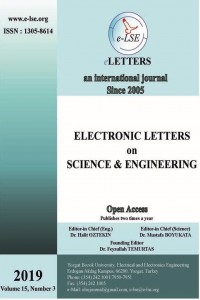Abstract
References
- 1. Takahashi, M. (2003) Development of High Strength Steels for Automobiles. NIPPON Steel Technical Report, 88, 1-7.2. Omura, T., Takahashi, T., Souma, A., Amaya, H., Numata, M., Arai, Y., Ohe, T., Ueda, M. (2015) Super-high Strength Low Alloy Steel OCTG with Improved Sour Resistance. NIPPON Steel and Sumitomo Metal Technical Report, 107, 18-23.3. Gavande, S. and Joshi, V. S. (2017) Elimination of Cracks Formation in Stainless Steel after TIG Welding. Proceedings of 88th ISERD International Conference, Dubai, UAE, 1-2 October, 15-19.4. Ren, X., Zhou, Q. J., Shan, G. B. and Qiao, L. (2008) A Nucleation Mechanism of Hydrogen Blister in Metals and Alloys. Metallurgical and Materials Transactions A, 39(1), 87-97.5. Cwiek, J. (2010) Prevention Methods against Hydrogen Degradation of Steel. Journal of Achievements in Materials and Manufacturing Engineering, 43(1), 214-221.6. Gomez, E. V., Amaya-Roncancio, S., Avalle, L. B., Linares, D. H. and Gimenez, M. C. (2017) DFT Study of Adsorption and Diffusion of Atomic Hydrogen on Metal Surfaces. Applied Surface Science, 420, 1-8. 7. Zhang, Z., Obasi, G., Morana, R. and Preuss, M. (2016) Hydrogen Assisted Crack Initiation and Propagation in Nickel-based Superalloy. Acta Materialia, 113, 272-283.8. Nagao, A., Smith, C. D., Dadfarnia, M., Sofronis, P. and Robertson, I. M. (2012) The rolr of Hydrogen in Hydrogen Embrittlement Fracture of Lath Martensitic Steel. Acta Mater, 60, 5182-5189.9. Wang, S., Martin, M. L., Sofronis, P., Ohnuki, S., Hashimoto, N., Robertson, I. M. (2014) Hydrogen-induced Intergranular Failure of Iron. Acta Mater, 69, 275-282.10. Robertson, I. M., Sofronis, P., Nagao, A., Martin, M. L., Wang, S., Gross, D. W. and Nygren, K. E. (2015) Hydrogen Embrittlement Understood. Metal Material Transactions B46, 1085-1103.11. Nagao, A., Martin, M. L., Dadfarnia, M., Sofronis, P. and Robertson, I. M. (2014) The Effect of Nanosized (TiMo)C Precipitates on Hydrogen Embrittlement of Tempered Lath Martensitic Steel, Acta Mater, 74, 244-254.12. Zrnik, J., Mamuzic, I. and Dobatkin, S. V. (2006) Recent Progress in High Strength Low Carbon Steels. METABK, 45(4), 323-331
Effect of Temperature and Strain Rate on the Embrittlement Behavior of Heat-Treated Carbon Steel (UNS) G10180
Abstract
The microstructures
of plastically deformed steel have been studied to potentially promote ingress
of atomic hydrogen raising its susceptibility to embrittlement. The as- received
UNS G10180, heat-treated to about 500oC was investigated to have
experienced ductile to brittle transition effect leading to the resultant drop
in mechanical duty. The apparent embrittlement of the specimen came after
series of controlled pre-stressing by quasi- static loading (fatigue cycling)
followed closely by pre-charging of the specimen with hydrogen in an ambient electrochemical
environment of hydrochloric acid. Standard tensile test were hydrogenated from
2 to 6 hours and deformed by cold worked to 40%, 50%, 60% and 80% mechanical and laboratory tests on the
dissolution and dissociation mechanism of the ions. The crack length and time
of failure at low strain situations was evaluated under the simulated
conditions. The results showed that by calculation, pre-charging with
hydrochloric acid raised the susceptibility of embrittlement of hydrogen specie
by 25%. Increment in temperature of the electrolytic bath by every 25oC
for the number of experimental hours further raised the susceptibility of the
failure of the metal by 15%. This led to lower tensile strength or low bearing
capacity by almost 10% compared to the as-received samples. The strain also
decrease due to pre-stress and pre-charging at the temperatures used. It can
therefore be said material like UNS steel can fail without apparent deformation
in the field assuming if subjected under high temperature and under high
loading, complemented by presence of acid attack.
Keywords
Hydrogen embrittlement temperature and strain rate Nucleation mechanical properties crack propagation
References
- 1. Takahashi, M. (2003) Development of High Strength Steels for Automobiles. NIPPON Steel Technical Report, 88, 1-7.2. Omura, T., Takahashi, T., Souma, A., Amaya, H., Numata, M., Arai, Y., Ohe, T., Ueda, M. (2015) Super-high Strength Low Alloy Steel OCTG with Improved Sour Resistance. NIPPON Steel and Sumitomo Metal Technical Report, 107, 18-23.3. Gavande, S. and Joshi, V. S. (2017) Elimination of Cracks Formation in Stainless Steel after TIG Welding. Proceedings of 88th ISERD International Conference, Dubai, UAE, 1-2 October, 15-19.4. Ren, X., Zhou, Q. J., Shan, G. B. and Qiao, L. (2008) A Nucleation Mechanism of Hydrogen Blister in Metals and Alloys. Metallurgical and Materials Transactions A, 39(1), 87-97.5. Cwiek, J. (2010) Prevention Methods against Hydrogen Degradation of Steel. Journal of Achievements in Materials and Manufacturing Engineering, 43(1), 214-221.6. Gomez, E. V., Amaya-Roncancio, S., Avalle, L. B., Linares, D. H. and Gimenez, M. C. (2017) DFT Study of Adsorption and Diffusion of Atomic Hydrogen on Metal Surfaces. Applied Surface Science, 420, 1-8. 7. Zhang, Z., Obasi, G., Morana, R. and Preuss, M. (2016) Hydrogen Assisted Crack Initiation and Propagation in Nickel-based Superalloy. Acta Materialia, 113, 272-283.8. Nagao, A., Smith, C. D., Dadfarnia, M., Sofronis, P. and Robertson, I. M. (2012) The rolr of Hydrogen in Hydrogen Embrittlement Fracture of Lath Martensitic Steel. Acta Mater, 60, 5182-5189.9. Wang, S., Martin, M. L., Sofronis, P., Ohnuki, S., Hashimoto, N., Robertson, I. M. (2014) Hydrogen-induced Intergranular Failure of Iron. Acta Mater, 69, 275-282.10. Robertson, I. M., Sofronis, P., Nagao, A., Martin, M. L., Wang, S., Gross, D. W. and Nygren, K. E. (2015) Hydrogen Embrittlement Understood. Metal Material Transactions B46, 1085-1103.11. Nagao, A., Martin, M. L., Dadfarnia, M., Sofronis, P. and Robertson, I. M. (2014) The Effect of Nanosized (TiMo)C Precipitates on Hydrogen Embrittlement of Tempered Lath Martensitic Steel, Acta Mater, 74, 244-254.12. Zrnik, J., Mamuzic, I. and Dobatkin, S. V. (2006) Recent Progress in High Strength Low Carbon Steels. METABK, 45(4), 323-331
Details
| Primary Language | English |
|---|---|
| Journal Section | Articles |
| Authors | |
| Publication Date | December 30, 2019 |
| Submission Date | July 12, 2019 |
| Published in Issue | Year 2019 Volume: 15 Issue: 3 |


